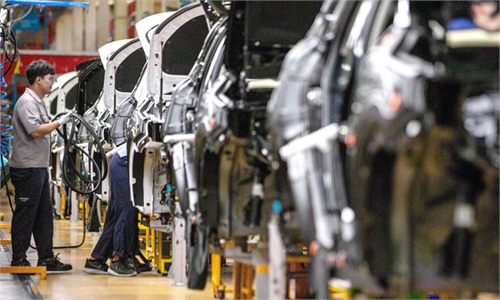
Illustration: Chen Xia/Global Times
Despite the naysayers in the US media denigrating China's economy, official data released last week showed China's third-quarter growth came in much stronger than expected, boosting hopes that the world's second-largest economy is almost certain to exceed the yearly growth target of around 5 percent in 2023. The figure proved to be another pleasant surprise for the world. The pundits' rhetoric that China's economic boom of more than 40 years is beginning to lose momentum is untenable and misleading.
The fourth-quarter growth rate is widely expected to reach at least 5 percent, considering the lower comparison base of 2.9 percent in the final quarter of 2022. Economists and investment banks have raised their estimates for China's GDP growth this year to 5.2 percent or even higher.
Important policy meetings, scheduled in Beijing prior to the year's end, including the annual Central Economic Conference, are anticipated to announce more substantive moves to boost the economy, in particular widely anticipated new policy steps to shore up support for the lackluster real estate and equity markets.
As it has done this year, China is expected to continue to focus on investing in modern infrastructure projects and digitalized modern services to anchor government spending and stabilize economic growth in 2024 and beyond. High-speed railways, express roads, solar, wind, hydro, nuclear and other green energies, electric vehicles, 5G and satellite-connected ubiquitous communication links, new urban metro systems, and major city hubs and urban clusters are expected to be expanded throughout the country. Heavy infrastructure investment is likely to persist in the foreseeable future, acting as a prime driver of China's economic growth.
The narrative that infrastructure investment must be replaced with domestic consumption in order to sustain an economy's growth is only partially true, because modern infrastructure is always the launch pad of lasting economic growth. Drawing experience from China's development in the past four decades, infrastructure investment, home consumption and exports have been proved to be the mutually reinforcing three levers or "troika" of GDP expansion.
Policymakers are expected to double down on efforts to ramp up self-reliance on homegrown high and new technologies, which will help transform and upgrade China's massive manufacturing sector, and also help accelerate the country's signature opening-up drive to integrate the Chinese economy more seamlessly with its Belt and Road Initiative (BRI) partners. After BRI partner countries, aided with Chinese investment and technology, embark on a path of sustained economic growth, China will gain more opportunities to grow foreign trade.
As witnessed by the world, the US government, since 2018, has resorted to a slew of sinister measures to torpedo China's economy and contain China's rise. The Biden administration inherited the trade war from the Trump government, and upped the gear on the technology attack on Chinese enterprises. To cope with the US ambush, it is imperative for China to accelerate technology investment to trigger a wave of "tech revolution" - like what Huawei has done - in order to defeat the US crackdown.
It is hoped that China could continue to make great innovations like what it has done in high-speed railways, electric batteries, ultrafast mobile broadband, space technology, and new and advanced defense capabilities. Only through constant technology endeavors can the country's economic strength be firmed up.
Acting as a policy plus, China's relatively loose monetary policy will continue to buoy up. The country's financial condition has remained largely accommodative and real policy rates are close to neutral levels, reducing the need for an early tightening of monetary policy, which is beneficial for GDP growth.
According to the National Bureau of Statistics (NBS), China posted 4.9 percent GDP growth in the July-September quarter from a year earlier, which was stronger than some economists' gauge of 4.4 percent. On a quarter-on-quarter basis, the economy grew by an impressive 1.3 percent in the third quarter. The second-quarter GDP growth rate was only 0.5 percent quarter-on-quarter. Unemployment also eased to 5 percent in September from 5.2 percent a month earlier.
Economic growth after China moved to optimize its anti-pandemic management at the beginning of this year has been uneven, as the third-quarter 4.9 percent GDP growth followed the 6.3 percent print for the second quarter and 4.5 percent growth for the first quarter. However, the divergence in quarterly growth rates is no basis for playing down or disparaging China's growth prospects in order to frighten investors away from China. The hypothesis that China may face a severe financial crisis or property meltdown like what the US encountered in 2008 is simply vitriolic and venomous.
The narrative that China's real estate sector problems, as seen in the financial woes embroiling a couple of debt-ridden developers like Evergrande, will deepen is untenable. In September, home prices in China's tier-one megacities rose again, meaning that buyers are re-entering the market. The support measures from the government to back the property sector are taking effect. September data for retail sales and industrial production were also better than media forecasts.
Seen comprehensively, China's "national economy continued to recover in the first three quarters, and high-quality development was steadily advanced, laying a solid foundation to attain the annual development goals", read a statement from the NBS, accompanying the release of the third-quarter data.
But facing the geopolitical volatility and risks of geo-economic fragmentation in the world, it is necessary to be somber-minded, and keep accelerating structural reforms that will help Chinese people's incomes converge more rapidly with those in advanced economies, by constantly closing productivity gaps between state-owned and private enterprises and further opening up the economy to the outside world.
The author is an editor with the Global Times. bizopinion@globaltimes.com.cn



